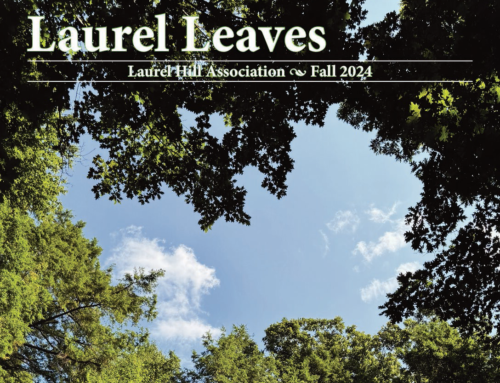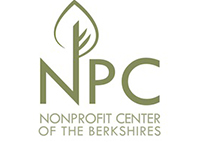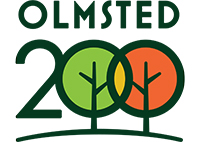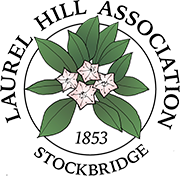LAUREL HILL ASSOCIATION
168TH ANNIVERSARY LAUREL HILL DAY
AUGUST 28, 2021
Laurel Hill Day started out a reasonably warm, but overcast day. The precipitation forecast for the afternoon was 20%, but we were confident it would not rain on our big day.
As 2:00 PM approached, attendees arrived and took their seats. The chairs had been spread wide across the grassy glen so as to be “Socially Distant” on account of the COVID-19 pandemic. Some people wore masks for additional protection. (The Delta Variant had caused a surge of infection recently.) The landscape clearing done as part of the Park Restoration Project allowed the chairs to be spread out easily. For the first time, an effective loudspeaker system had been installed for the day. All attendees could hear, no matter where they were seated.
Welcome
At 2:10 PM, Association President Hilary Somers Deely came to the podium and started the Program.
Welcome Friends and Neighbors, and thank you for coming to Laurel Hill Day 2021. Today is the 168th anniversary celebration of the founding of the Laurel Hill Association. I am Hilary Somers Deely, the newly elected President. Today is both our annual celebration of the Legacy and land we help maintain. Therefore, as we begin our program it is appropriate that we acknowledge that:
We stand on the ancestral homelands of the Stockbridge Indians. We honor with gratitude the people who
have stewarded the land throughout the generations and their ongoing contributions to this region.
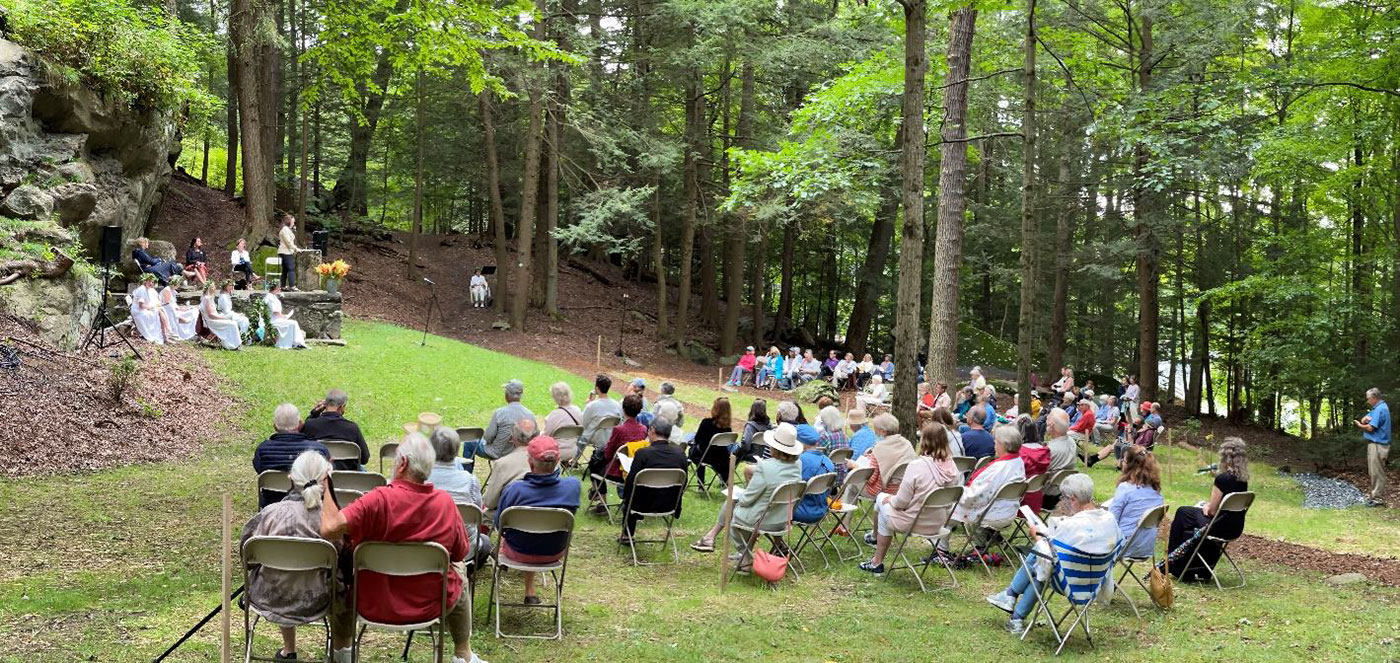
As we will be speaking today of the role of women in the history of Laurel Hill and beyond, I should point out that, NO, I am not the first woman president of this hallowed association. The first woman to be elected President was our unforgettable Mary Flynn. Mary was so good at running things she actually did it for two 3- year terms!
The past year has been one of the most memorable in this long history. Our patrons continued to enjoy our open spaces to find recreation and solace as we all dealt with the impact of COVID. More than ever, in the last twelve months, the Laurel Hill Association has fulfilled our mission to contribute to the quality of life in Stockbridge.
At our properties we are proud to provide a diverse range of experiences for one and all; from strenuous hikes up to Laura’s Tower to gentle ambles along the banks of the Housatonic. Whether looking out to a great vista or sitting reading a book in a sun dappled glen, running to keep up with a bounding dog, or herding a clutch of children—Laurel Hill’s properties are available to all, year ’round, at no cost. It is very appropriate that we pause once a year to celebrate this all-volunteer organization that works so hard to do their best to share this 460 acres of Greenspace with today’s visitors and to preserve it for generations to come.
This year we have chosen as the focus for our program “A Celebration of Women.” In the early 1800’s Mary Hopkins Goodrich, our founder, provided leadership in an era when women’s contributions were often overlooked. In 1853 Mary was inspired to establish the Laurel Hill Association following a horseback ride she took during a visit she made to see her family. Mounted on an imposing white horse she rode through the Stockbridge Cemetery. Mary was shocked by what she found there. The cemetery was a mess!! It was overgrown with brambles, weathered headstones toppled over, weeds and wild grasses clogging the open spaces. (Sigh.)
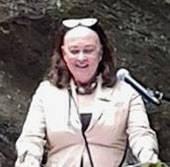 As Mary surveyed Stockbridge, her adopted home, she saw no sidewalks to keep the passersby’s feet out of mud and muck, safe from the raw sewage running in the streets which produced, and I quote, “odiferous smells.” Mary decided, on the spot, to form an association to clean up the quaint village of Stockbridge. Her brain child became The Laurel Hill Association, the nation’s first Village Beautification Organization.
As Mary surveyed Stockbridge, her adopted home, she saw no sidewalks to keep the passersby’s feet out of mud and muck, safe from the raw sewage running in the streets which produced, and I quote, “odiferous smells.” Mary decided, on the spot, to form an association to clean up the quaint village of Stockbridge. Her brain child became The Laurel Hill Association, the nation’s first Village Beautification Organization.
In her history of Laurel Hill, Margaret French Cresson wrote:
“A beginning had been made. Mary Hopkins’s vitality and Energy showed good signs of bearing Fruit. She had a way with Her and could Charm or Ridicule as the case demanded. Her keen sense of Humour and spicy tongue kept people amused while she shamed them out of their shiftlessness!”
Mary and like-minded members went to work! in early years there were no such things as a Department of Public Works so the association took on funding the construction of civic amenities like sidewalks and waterworks. In order to preserve these lands, sacred to the native Americans who had inhabited Stockbridge, the association established The Laurel Hill Reservation, consisting of property deeded to the town of Stockbridge as a generous donation of the Sedgwick Family. A central feature of the new holding is the park in which we now sit.
The Association flourished, and by 1912 The New York Times headlined: “Laurel Hill Association is Attracting Attention All Over the Country.” The lengthy article went on to chronicle the 1500 village beautification organizations that had sprung up patterned after our own Laurel Hill.
Now I need to point out that for the first twenty years of Laurel Hill’s history, women were not allowed to come up here on the rostrum to speak. Even our Founder had to stand in the audience and say her piece! This changed in the third decade when Mary went front and center to address the Laurel Hill Day Audience.
Though women had gained influence and visibility in civic organizations it was not until 1919 that Women won the right to vote. AND, another celebration here today is the 102nd anniversary of the brave suffragettes. It took more years of struggle before women of color and indigenous peoples were assured full access to this basic right to vote. Achieving this milestone required a lengthy and difficult struggle that took decades of reform, agitation and protest.
As we look back on our 168-year history, we see the emergence of our Association as a mature community group, devoted to stewardship of land and enhancing the beauty and quality of life in the town and the surrounding Berkshires.
Although our bicentennial is still 32 years in the future, we can speculate what challenges lie ahead not only for Laurel Hill and the town of Stockbridge but also for our nation and our precious, increasingly fragile, planet:
Can the Laurel Hill Association once again serve as a national model as we deal with the inescapable impacts of climate change, extremes of temperature, more frequent and fiercer storms, accelerated change in composition of forests due to invasives, and warming median temperatures?
Can we hope that by 2053 all of the glass ceilings that frustrated Mary Hopkins Goodrich and generations of women who succeeded her will, at last, have been broken through?
Our program today speaks to all three stages of the Laurel Hill Association; the achievements of the past, our contributions today, and our dreams of the future. Laurel Hill is honored by the presence of all of you in our audience, and we invite you to join with us as we hike into that future, guided by our mission to enhance the quality of life in Stockbridge and the Berkshires.
Thank you.
Note of Passing
President Deely continued:
Now before we get started with our program in celebration of women’s accomplishments, I would like to make note of the passing of one of our presidents…Homer [“Skip’] Meade. Skip led this organization from 1990 through 1992. His Funeral was this morning. Skip was truly a gentleman and a scholar, and his caring, thoughtful and inclusive manner was a gift to all who knew him. I’d like to ask for a moment of silence for Skip.
Invocation
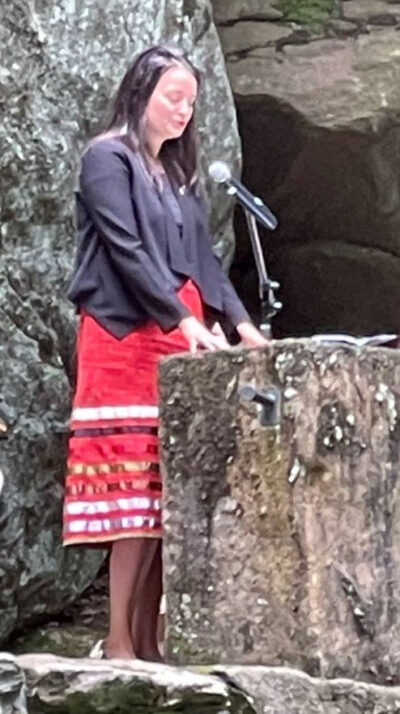 President Deely then announced:
President Deely then announced:
There has been a change due to the COVID-19 pandemic that is raging across this country. President Shannon Holsey of the Mohican Stockbridge-Munsee Nation felt it was not safe for her to travel from tribal lands in Wisconsin to participate in our program, but we are extremely lucky to have as President Holsey’s representative, Bonney Hartley.
Bonney is the Tribal Historic Preservation Manager of the Stockbridge-Munsee Nation. Bonney holds a Masters of Social Science from the University of Capetown, South Africa, and in 2013 Bonney was awarded the American Indian Local Hero Award by the San Francisco Mayor’s Office. We are honored that Bonney will deliver the invocation, a poem written by a tribal member and then share the remarks President Holsey had hoped to deliver in person.
Bonney Harley (pictured right) came to the podium and read the following poem for the Invocation, written by tribal member Theresa Beaulieu.

You Are One Who Walked Yesterday
You are one who walked yesterday Pulled from your place in time, And now I see
That your feet once stood here Imprinting the earth where I stand, In moccasins I will never see Dancing
Bending in this same sun,
To a song I will never hear
The stories you would have told Were silenced by other tongues, Yet your blood is in mine
A link over time
I imagine your life from these feelings Though I see
You belonged undisturbed Covered with this dust we share, Now walk with those who are gone Aapaachiiw [He/She returns]
Theresa (Miller) Beaulieu
Member of the Stockbridge-Munsee Community, Band of Mohicans
June 10th, 1997 – Stockbridge, Massachusetts
Bonney followed the Invocation poem with the remarks from Tribal President Shannon Holsey.
Koonamunthe? [Are you well?] I hope you are well., it is my honor as a Mohican woman to be back on our homelands and to speak on this hill. My name in our language is Taehaequondoheet, meaning,”she has her arms around the people.” I would like to acknowledge that Laurel Hill is the beloved lands of Mohican Jacob Tussunnuck and family, who made their home right here where we are assembled. There was a hearth over here, tended to by Mohican women, and water drawn from the Housatonic. All the ancestors of yesterday are still here in our People.
Mohican women in our traditions are respected as the source of life, and we see our relative inOur Mother, the Earth, who has given us all we need for life. Our Grandmother, the moon, controls the water of the oceans, including our namesake, the Muhheaconnituck, or Hudson River, the water that flows both ways, as it is guided by the tides. In Grandmother moon’s relationship to all women of the world, she shares a responsibility for the birth of children. Themoon constantly changes, and she brings song and poetry from our thoughts.
During our history here in the Berkshires, these beautiful, abundant homelands, our Mohican Women gathered materials, and collectively created our baskets and brooms, and prepared ourcollective feasts. They were a revered role as clan mothers. They decided who was to lead. Theythemselves negotiated important agreements. Long before colonization, Mohican women werediplomats among neighboring Native Nations. Since colonization, Mohican women continued this political role and engaged in treaty talks—women such as Manveht and Pewasck in our Muhheaconnituck or Hudson Valley homelands, women who engaged in land agreements throughout the Berkshires such as Naunausqwoh, and women here in Stockbridge such as Rhoda Quanponwos, Roxy Seebuck, and Hannah Mhuttawampee.
When you look at our history you see that Mohican women have always engaged in creative adaptation to the pressures we have faced. That is the Stockbridge-Munsee experience— undercolonization and the missionary experience here in Stockbridge, and our many forced removals until today, we have adapted and brought our values forward into the future.
Here in Stockbridge, Stockbridge Mohican women were not allowed to sit on the English-styletown council established here. However, they took part in community council fires beyond theEnglish colonist reach. They continued to be carriers of oral tradition, language, medicinal knowledge and traditional crafts making. Women’s status did not significantly change. We adopted the outward trappings of the English but at the core community level the roles and values endured.
After our forced removal from these lands, when Mohican people were no longer seen of great value after service in the Revolutionary War, Mohican women adapted and persisted and applied the lessons from the Stockbridge Mission to the Tribe’s new home in New Stockbridge, New York among the Oneida. Many Mohican men had died in service to the country in the War.Mohican people became a Nation of Women. And the women responded.
Women such as Lydia Quinney negotiated with Quakers in Pennsylvania to educate Mohican girls. A 16 year old Kauknosquoh or Mary Peters operated her first school for Stockbridge children, which included teaching knitting. It grew to two more schools taught by Kauknosquohand Margaret Mautawsquaw. The crafts created at these schools supplemented the community’s income as well as perpetuated traditions—the profits were shared equally. By 1815, the handful of young girls that had begun in the schools had grown to 60 women and girlsproducing hundreds of yards of flax and wool annually. These entrepreneuring Mohican womentook the tools of the Quaker missionary education, but applied their own traditional wisdom and practices.
In addition to being educators and entrepreneurs, clan mothers and community networkers, Mohican women continued to serve our traditional role as stateswomen, in the new early America: women such as Kauknosquoh of the spinning school success were also diplomats and treaty signers— Kauknosquoh held power of attorney for the Tribe and travelled to Albany in 1818 where her famous uncle Aupaumut was leading land negotiations to finance the Tribe’s next removal out of New York State to Indiana. Kauknosquoh spoke out against it, voicing that the women had made such progress in building the New Stockbridge community that it would be detrimental to start over. After our eventual removal to Wisconsin, Mohican women such asElecta Quinney continued to adapt and lead. Trained in New York, Electa came to Wisconsin in 1827 and founded the state’s first public school.
When women’s suffrage was passed in 1920 for white women, this did not include everyone— Native women, such as my own grandmother Thelma Putnam, Nahananasquah, (born in 1901),could not vote in US elections until 1924. When this finally did take place, it only reinforced at the US Government level what our Native women had always traditionally done—been a central part of democratic decision making. My grandma went on to become civically active, asMohican women always had been, traveling to DC with delegations to retain our Wisconsin lands, and returning here to Stockbridge to build bridges with women at the churches and libraries here— copying records & historical documents to bring back to our people.
Today, women such as our President Shannon Holsey are empowered 21st century Mohican women who continue to adapt and lead and keep the Mohican council fires bright. All of our Tribal Council officers— President, Vice President, and Treasurer— 3 out of our 7-member elected leadership, are women, again. When we look back to our first major disruption of political life here in Stockbridge in the 1700s, we can be proud that we have come a long wayand that underneath the imposed viewpoints of colonization, we continued to persist as a woman-led community.
I think our cherished elder “Aunt Dot,” Dorothy Davids, a respected peace activist, educator and trailblazer, shared the Mohican women’s experience well in saying, “When you go into the world, take your whole self with you—take your roots and plant them in your new world.” Thatis the way that Mohican women have modeled, time and again. That is our superpower!
Oneewe [I appreciate.]
Song with Trumpet
Solo trumpet, Dr. Karen Lavoie, played one verse of “For the Beauty of the Earth”. She was standing off to the right of the Rostrum, among the trees at the start of the Adams Path.
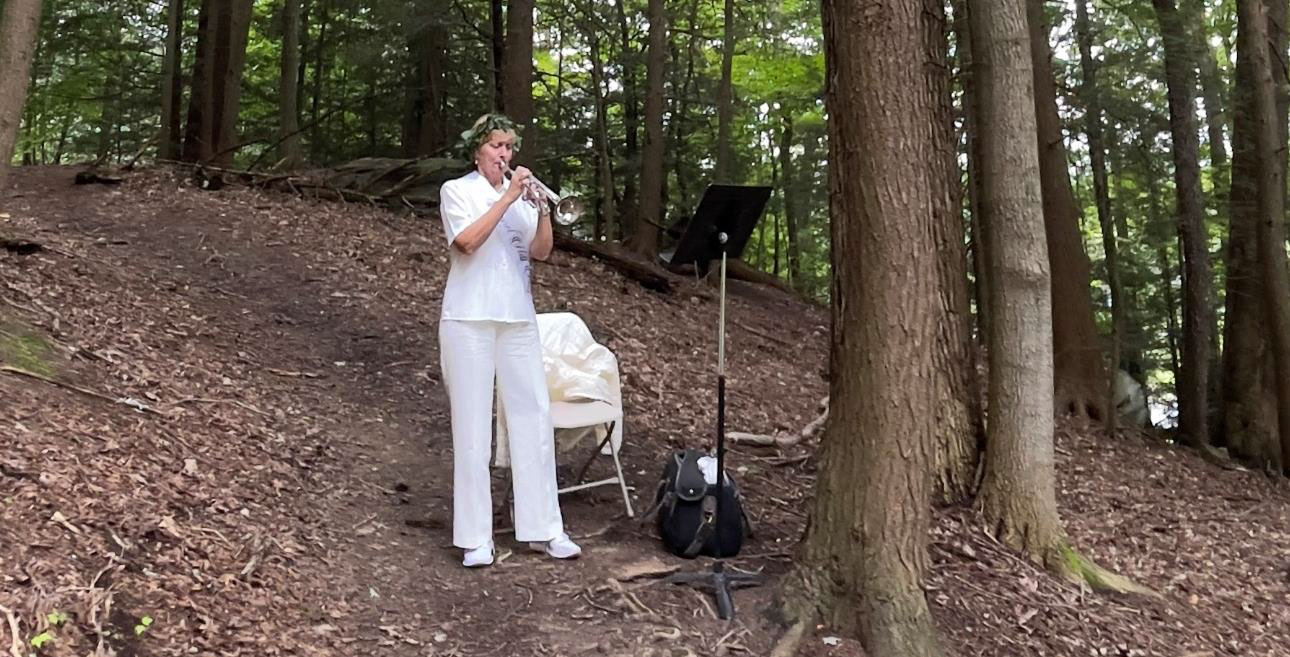
Procession
During the trumpet solo, six Suffragettes, sitting to the left of the Rostrum, rose and came in front of the Rostrum platform. They wore laurel head wreaths, and sashes which read: “Laurel Hill Day 2021.” The first two carried a laurel swag, which they draped over the arms of the Rostrum desk. Then they all sang the first three verses of the song, accompanied by Dr. Lavoie on the trumpet. They motioned the audience to join in (using the music insert in the Program.) Following the song, the Suffragettes went back to their seats.
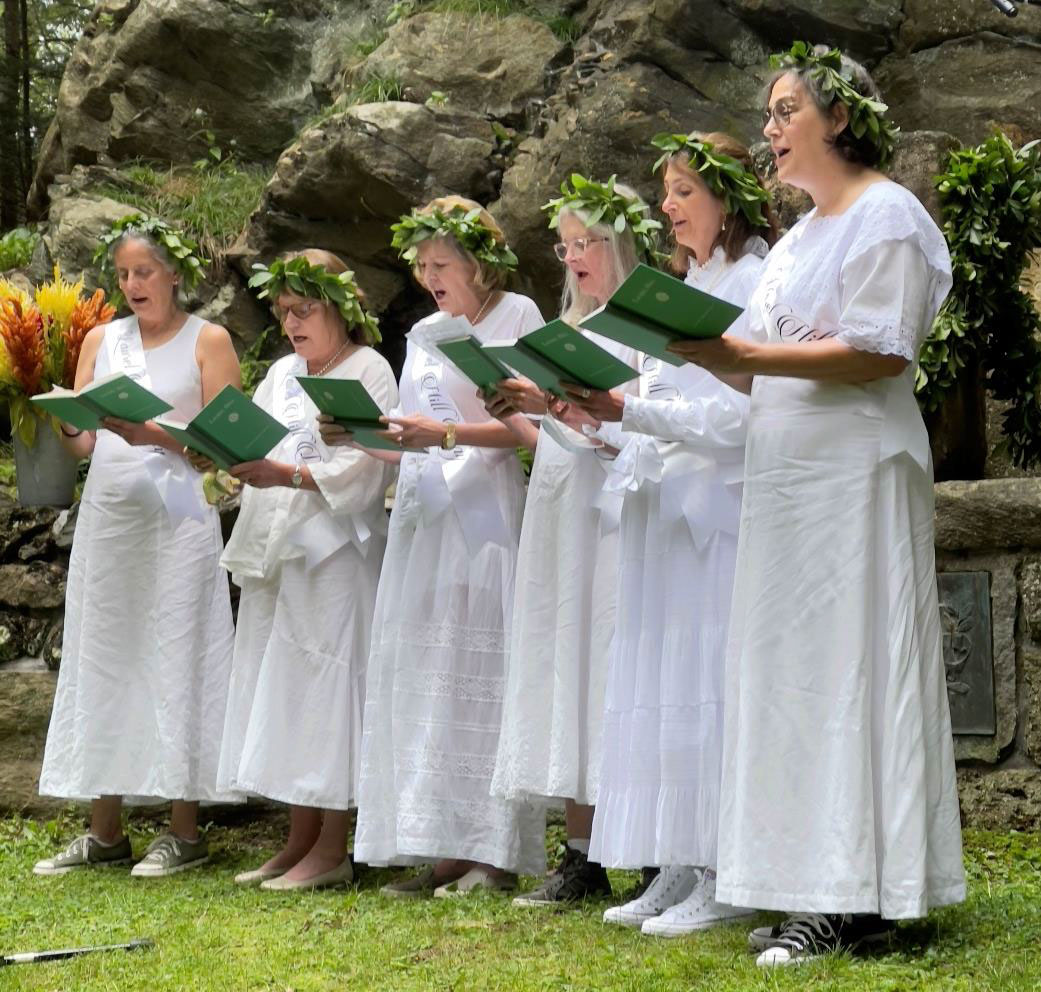
The Singing Suffragettes
(L to R) Kate Fletcher, Ramelle Pulitzer, Kate Morris, Barbara Sims, Lis Wheeler, Angela Cason
Memories of Laurel Hill
President Deely returned to the podium.
Now it gives me great pleasure to introduce some special Ladies who will share anecdotes about their time in Stockbridge and with Laurel Hill. This group, I might add, run the gamut:
— from the niece of Miss Mabel Choate,
— two lovely sisters (the father of whom built the shed at Tanglewood, built the Ted Shawn theatre, as well as many features of Laurel Hill including our beautiful Goodrich memorial footbridge and Laura’s Tower),
— AND, of course, Laurel Hill’s own, Heart and Soul, who has worked in our association for forty years, Patricia Flinn.
Suffragette Barbara Sims brought a handheld mike down to the ladies who were seated in the front row.
Celia de G. Kittredge
My name is Celia de Gersdorf Kittredge. Having grown up in Stockbridge, Laurel Hill is very much a part of our lives. And I remember coming every Laurel Hill Day with my parents, when I was no age at all. There are several things I remember, though, about Laurel Hill…starting at the foot of the driveway, sliding down the stones and getting scolded severely at home for ruining my pants, which I’m sure I did.
Then I have a picture during the [Stockbridge] Bicentennial in 1939 of Gerry (Geraldine) Treadway and myself, and I think somebody else, standing right up there at the corner in our colonial dresses for the Bicentennial, which we hated…couldn’t wait to get back in our blue jeans.
So anyway, Laurel Hill has meant a great deal to me, it’s my memory as a child always. What Hilary is doing is wonderful. Thank you.
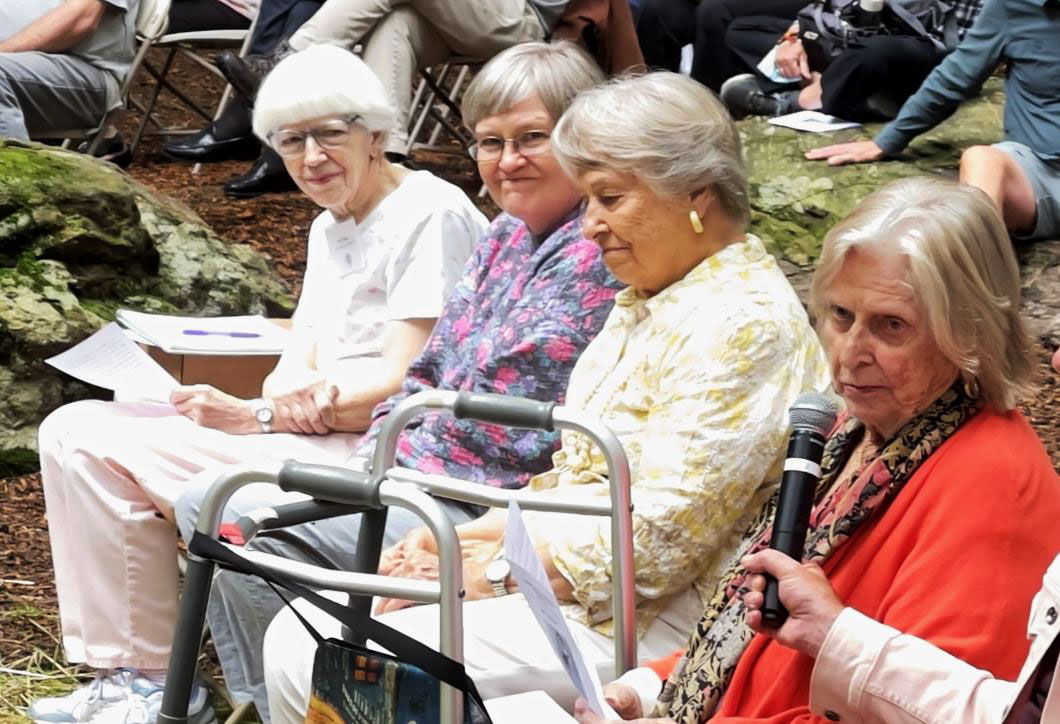
Celia Kittredge (right) makes her remarks. Waiting their turn are Shirley Franz Miller (2nd from right, accompanied by her daughter Jennifer Rambridge, 2nd from left) and Pat Flinn (left).
Shirley Franz Miller
Hi, I’m Shirley Franz Miller. Our family has been involved with Laurel Hill for many, many years. My mother and father were both members of Laurel Hill for many years. My father served as treasurer for thirteen years, from 1927 to 1939. My mother was chairman of the “7th District” in 1926 – I don’t know what “7th District” was – but that was the year she was married.
Of course, our father did an awful lot for the town too, as well as the things mentioned before. He laid the underground lighting system for Main Street, so there were no overhead wires. He made the Stockbridge Library’s old addition match the new addition when that was added. And he did other things around town.
Other things I remember, and I’m speaking for my sister now…she couldn’t make it up the hill…we were both in the Bicentennial Pageant as was Celia. We were, mother and my sister, brother and I, were dressed as Indians for the pageant. And my mother made the costumes. Later, Peter appeared as a Japanese Beetle, because of the year that the Japanese Beetle had invaded the area, and they wanted to demonstrate that I guess. Our friend Bobby Hiden was also a Beetle. Our father made the papier-mache Beetle things.
Thank you.
Patricia Flinn
Hi, I’m Pat Flinn, Patricia Flinn. In my years as Secretary, I’ve documented many Laurel Hill Day programs. But what I’m about to read you is from a program 120 years ago. It is, hands down, my favorite.
In her book Memories of a Sculptor’s Wife, Mrs. Daniel Chester French gives an entertaining account of a Laurel Hill Day from the early nineteen hundred’s. It seemed that the sun was shining directly into the faces of the celebrities sitting on the Rostrum, making them look rather uncomfortable. “Suddenly a little old lady in the front row came to the rescue. She struggled up across the intervening space, tripping over her long skirts and the uneven ascending ground. Arrived at the stone barricade she held aloft the dainty little emblem of a by-gone femininity.
Mr. Choate leaned down and accepted it as if he were receiving an honor from a sovereign. He turned it about, admired it and then he and the Bishop, who happened to be next to him, cuddled down under it and smiled pleasantly, like two big, happy boys at their friends left out in the sun.
Then a second little old lady became inspired, toddled up, tripping over her skirts and presented her little beruffled offering. And then a third!
And there they sat, the diplomat and the churchman, the man of letters and the scientist, the politician and the professor, all in a row and all smiling, all with little parasols, black and white and fluffy, above their heads.
Recognition of Area Women
President Deely rose to the podium.
Before I introduce our Keynote speaker, I want to take this opportunity to recognize and celebrate some of the people here who work every day to improve the world we live in. Please stand for a round of applause if you are working or have worked in the Creative Arts, the Environment, Politics, the Sciences, Libraries and Education. Or any leadership position. Our beautiful Berkshires would not be the same without your commitment and passion.
Keynote Presentation
President Deely then introduced the day’s featured speaker.
I am honored now to introduce our Keynote Speaker, Jennie Ann Kassanoff, a professor of English at Barnard College, Chairwomen of the Jacob’s Pillow Board, and the recipient of both of Barnard’s teaching awards: The Teaching Excellence Award in 2003 and The Emily Gregory Award in 2011.
Jennie’s research focuses on post- Civil War American Culture. She is currently at work on a book about Voting, Race and Gender in American Culture, the working title of which is called, “Voter Writes”. She is also the author of “Edith Wharton and the Politics of Race” and many other published articles. Jennie received her PhD at Princeton University, her MLitt at Jesus College, Oxford, and her BA at Harvard University. We are thrilled to have Jennie speak from our Rostrum at Laurel Hill Park.
Dr. Kassanoff started her presentation.
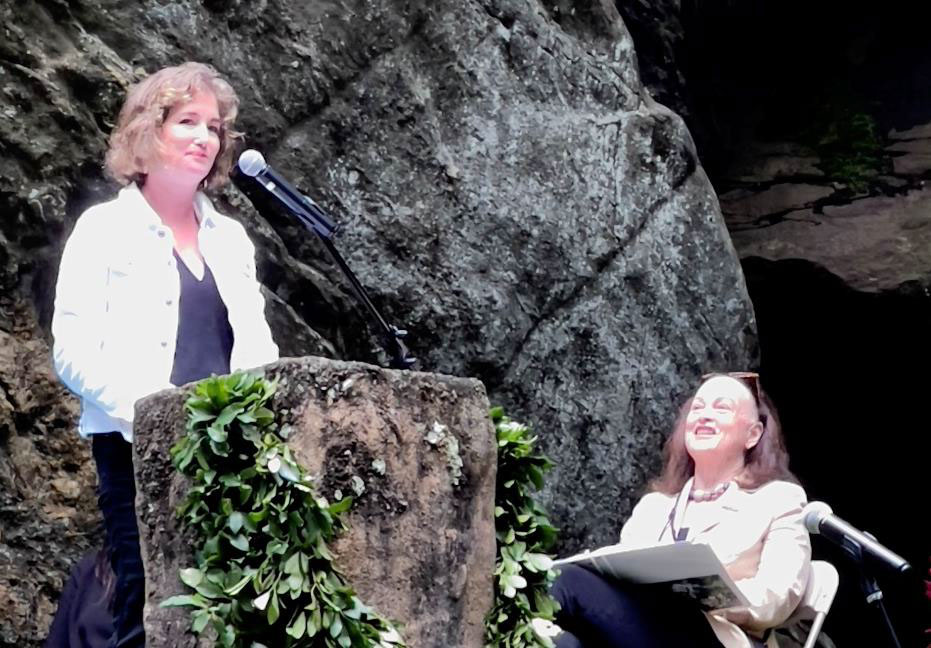
Keynote Speaker Jennie Kassanoff with Hilary Somers Deely looking on.
Part way through, intermittent rain sprinkles started falling. Someone handed an aqua umbrella to Jennie, who proceeded without hesitation. The audience was undaunted; no one moved. After about ten minutes, the sprinkles stopped.
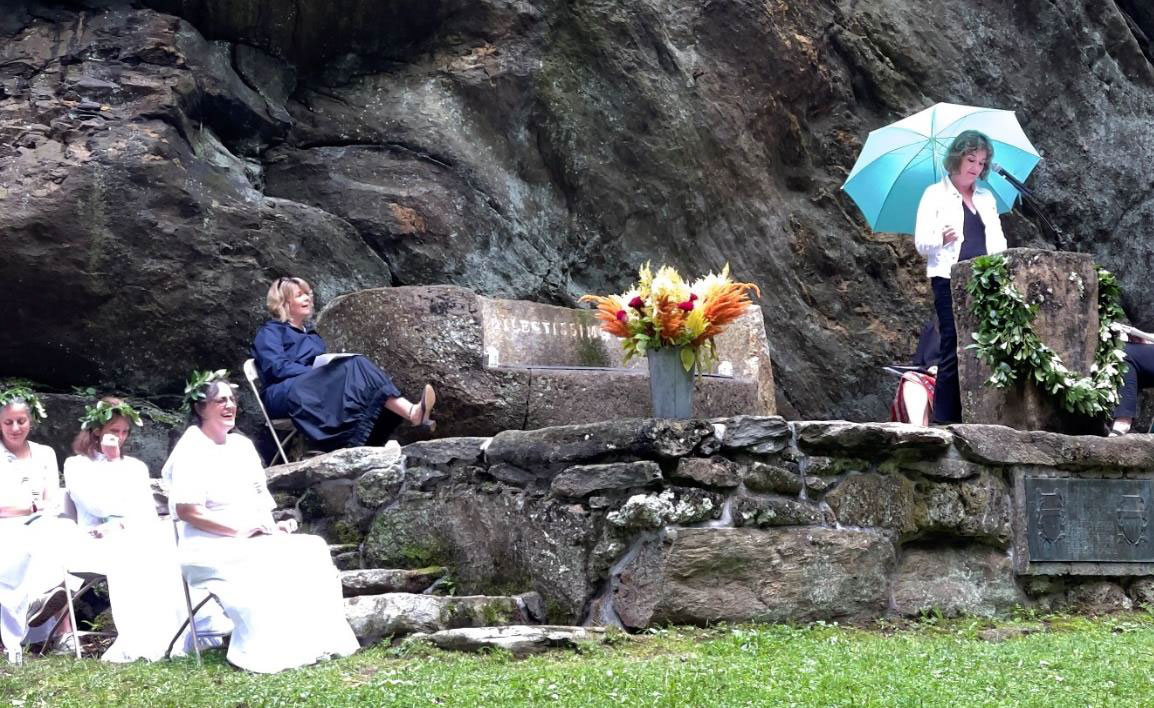
Dr. Kassanoff carries on, while Rev. Liz Goodman and the Suffragettes listen.
[Dr. Kassanoff’s remarks are not available for publication.]
Park Restoration
President Deely started the next introduction.
Now I am pleased to introduce another brilliant woman, Laurel Hill’s own member of the Properties committee, Susan Bubenas, who will bring us up to date on the Restoration of Laurel Hill Park, and all the hard work this incredible board has been doing in preparation for this celebration and for the beauty of the Park.
Susan Bubenas came to the podium.
Thank you, Hilary. This is not in my little script, but if you take a look around, there are well over a hundred people here, and you are dwarfed by this setting. So, thank you for coming and putting everything into
perspective.
To begin, our sincere thanks to all those who assisted over the past 3 years to make this restoration possible.
They are listed on the back of your program. There are too many people to name individually, but collectively…thank everyone. This work was a collective effort and was made possible in part by grants from the Community Preservation Committee and the Lenox Garden Club. I do have to do a shoutout to the Stockbridge Police Department, who have unwaveringly this summer moved those cruisers more times than you can count, to make sure we could get up here to do the work. Kim Shaw, we thank you!!
To those of you sitting on the rocks, I thank you, because those rocks were not visible two months ago. So,
we are happy that you have found them.

The rock area uncovered and cleared during the recent Restoration project.
My purpose today is to try and convey a bit of bigger picture, the context, if you will, of what has been done and what still requires our attention.
The ‘restoration’ and attention paid to Laurel Hill Park by the Laurel Hill Association speaks to the larger issues facing all of us – the issue of respect & honor for the past and the importance of history in our collective future.
To “restore” implies there is something to, in essence, return to.
A healthy ecosystem creates conditions for natural healing and therefore sustainability and are the hallmarks of our efforts as we are given the task of restoring the Glen not only to a state more like its original, but one that is also resilient to face the challenges of the coming decades in both its natural and made-made features.
We have thus far done “judicious” and selective work on the ground so as to protect the potential presence of artifacts below ground belonging to the Stockbridge Munsee Mohican community. For example, when the laurels were replanted in certain areas, archeologic work was funded by the Association to ensure the security of what may lie below. As many of you know, the Mohican presence is significant to much that we value today in Stockbridge.
Current work this summer sought to normalize select, open areas in the Glen to mitigate the erosion due to run off and alleviate compaction on root zones by adding composted mulch & soils without below ground disturbance. We have done tree work, exposed boulders from years of leaf litter to allow seating & viewing to re-emerge. We have seeded and mulched, covered with straw and/or wood chips to secure the soil, protect tree roots, and provide a more consistent surface for walking.
Improvement to the access way was done out of a need for both access and safety. There is now signage where there was none. There is still trail re-routing, trail healing and arboreal work still to be done. There is more signage to come. And as we move forward, if there is work where there might be ground-disturbing activities there will be consultation with the Stockbridge-Munsee Tribal Community.
The deed for the property upon which we convene today was conveyed by the Sedgwick family to the Laurel Hill Association in 1878 and the deed dictates that the premises are “dedicated…to the use benefit and pleasure of the public intending that the same be protected and preserved forever for that purpose.” We are committed to the dictates of the deed as conveyed.
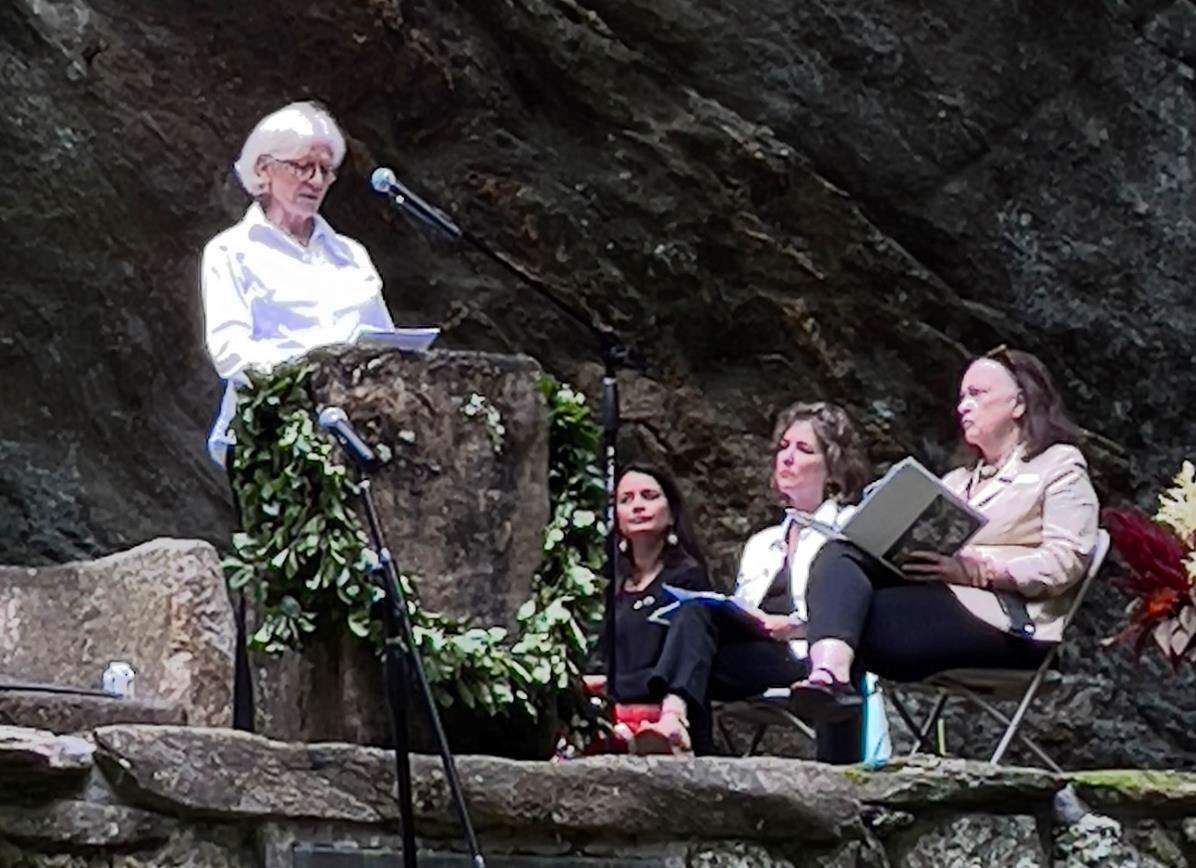
Susan Bubenas tells of the Laurel Hill Park Restoration, while
(L to R) Bonney Hartley, Jennie Kassanoff, and President Hilary Somers Deely look on.
It is our namesake property and for good reason. It is a park, a place, and most importantly, it is a state of mind. I have never walked up to the Glen and not felt its majesty and sanctity. Visit any time of the year, any time of the day and if you pay attention, it will speak to you.
The ‘restoration’ of its historical, human elements and the work to better reveal its natural beauty are the goals of the continuing ‘restoration’. If we do it well, we will honor the past and share it properly with the future.
As I close, I thank Pat Flinn, our “keeper of the institutional memory of the LHA” for initiating, writing the content, and championing this project more than 3 years ago. Pat, single-handedly, wrote RFPs and supervised tree/overgrowth removal, laurel planting, and rostrum/inscription/’arms’ work.
Finally, we owe a debt of gratitude to Shelby Marshall, the LHA president from 2015-2020. Shelby, working with Pat was instrumental in making Pat’s vision real by writing two grant applications and then managing the grant process and its reporting. Shelby initiated the work in the Glen, which I assumed after his term ended. Most importantly, however, during his six years as President, the organization changed from being reactive to proactive as exemplified by the creation and implementation of a Strategic Plan, it started outreach via friend raisers/Taggart House events, it increased its visibility with signs, the committee system strengthened, and Governance was instituted.
We have not had the opportunity to formally acknowledge Shelby’s contributions and legacy in this past pandemic year, so we thought it most fitting that his legacy be commemorated on our first bench, the President’s Bench, now located in the Glen of this Park. Everyone who visits, who rests a bit and who enjoys the majesty of this place will also know of Shelby’s role in its restoration as his presidential plaque will be the first and only for a while.
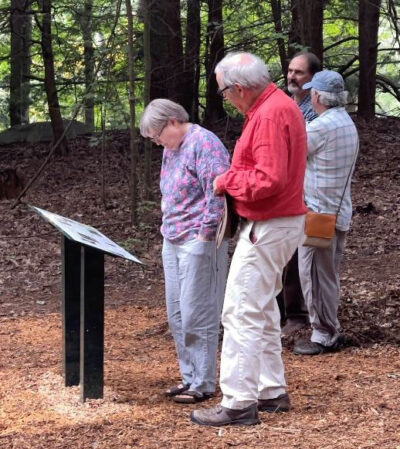
The new Interpretive Sign
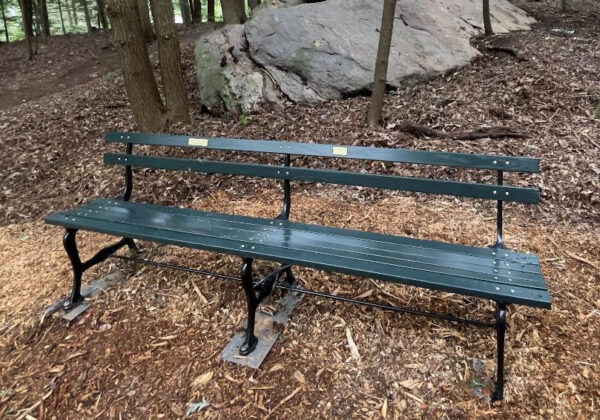
The new President’s Bench
Song with Trumpet
President Deely continued:
Before we sing our next song, I would like to take a moment and say a few words about our wonderful trumpeter Dr. Karen Lavoie. Dr. Lavoie is the Professor of Music and the Director of the Wind Symphony at Westfield State University in Westfield, MA. She has been a guest conductor and adjudicator for district and All-State festivals and clinics in Maine, Massachusetts, Connecticut, RhodeIsland, Minnesota, and Iowa. Dr. Lavoie was the first woman to receive the Doctor of Musical Arts Degree in Band Conducting from the University of Iowa. We are so grateful to have her with us today.
The Singing Suffragettes and Dr. Karen Lavoie will now teach us the Laurel Hill song. Yes, we have our own song! Please look at the insert in your program. Dr. Lavoie will play the Tune once on the trumpet, then we will all join our voices together, assisted by our Suffragettes.
The Six Suffragettes came forward, and accompanied by Dr. Lavoie, sang all four verses of “Old Laurel Hill”. Again, the audience was encouraged to join in.
Benediction
The Benediction was introduced by President Deely:
Our benediction today is from Pastor Liz Goodman. Liz Is the pastor of the Monterey Church and the Church on the Hill in Lenox. She Lives in Lenox with her husband Jesse and their two sons. Liz’s roots go back to the earliest days of the European pilgrims and settlers in the Berkshires, including Stephen Hopkins and William Sedgwick, of 17th century Stockbridge and Lenox, respectively.
Rev. Goodman came to the podium.
I want to thank you all for having me. I might be the newest person here to Laurel Hill Association. I’ve enjoyed the public lands and the trails for a long time, but never had the opportunity to know who’s been responsible for keeping it all. And my lineage sounds impressive, but I think a better way to describe it would be a roving drunken Dutchman [as Dr. Kassanoff referenced], because that’s how I ended up here.
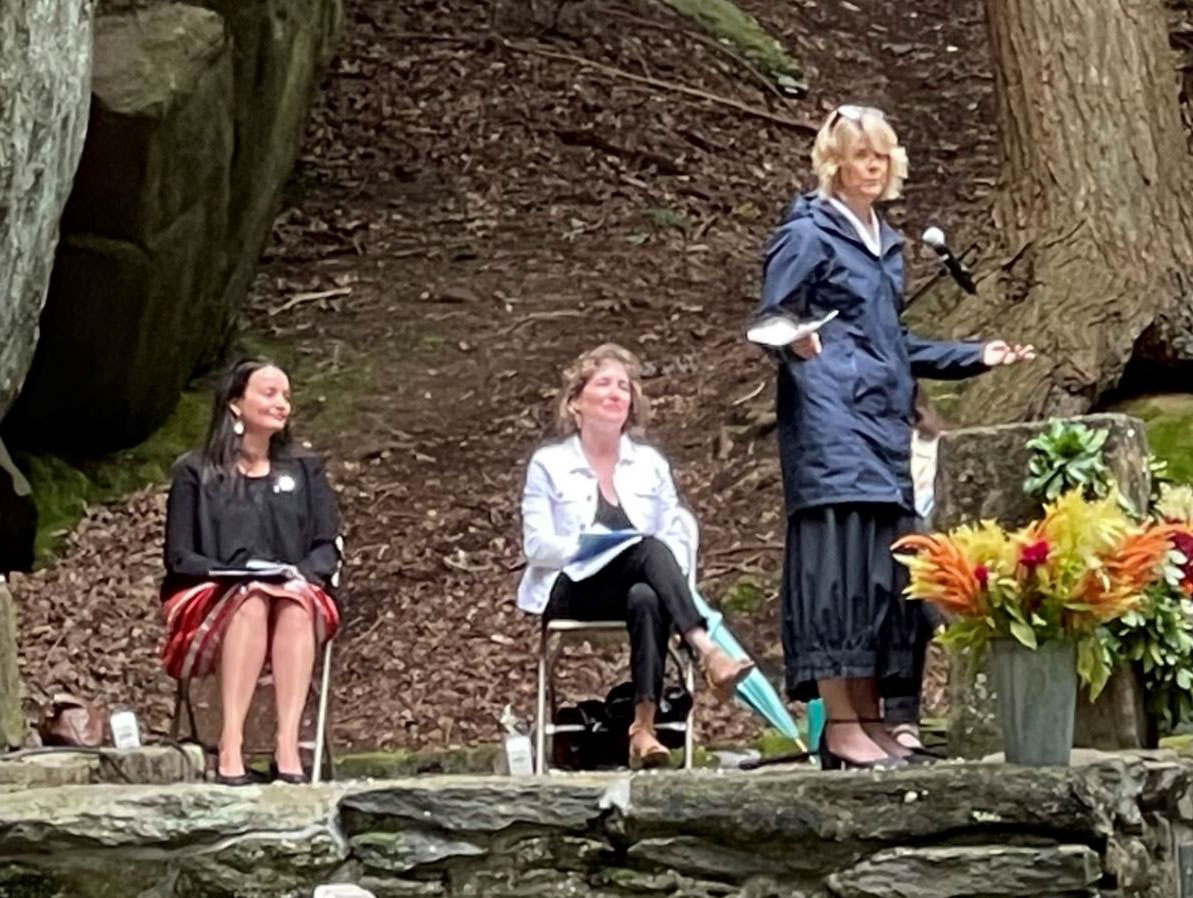
Minister Liz Goodman gives the Benediction, while Bonney Hartley and Jennie Kassanoff look on.
So, thank you all, and please join me in this final word, this good word…Benediction is just a “good word.” So, in this lovely place where good words have abounded, I won’t add too many more.
I just want to honor Mary Hopkins Goodrich and the many women who came before her to steward this land, and the many people who have come since, to ask that the External Spirit who creates, and sustains, and redeems in love, might continue to bless us and keep us—we gathered here on Laurel Hill, and all near and far today—that this same spirit might grant us all a thirst for justice with the aim of peace. Thank you.
Closing
President Deely had some final words.
In Closing, I would just like to thank everyone who attended today. And before we dig into the incredible delights that the Red Lion Inn and Julie Edmonds have provided for us, I want to call up the Suffragettes for a bow. They have worked for weeks on this program. They are: Angela Cason, (Musical Director,) Barbara Sims, Kate Fletcher, Kate Morris, Ramelle Pulitzer, Lis Wheeler, and our trumpeter, Dr. Karen Lavoie. Let’s have a hand for these wonderful women, and then join us for some socializing at the refreshment table.
Thank you!
The six Suffragettes came forward and were recognized.
As everyone made their way to the refreshment tables, Dr. Lavoie played one verse of “Joyful, Joyful, We Adore Thee” as a recessional.
Refreshments
Participants and attendees enjoyed the bounteous Red Lion Inn fare: sushi, cookies, brownies, and lemon squares. Individual, environmentally friendly boxes of water were also available.
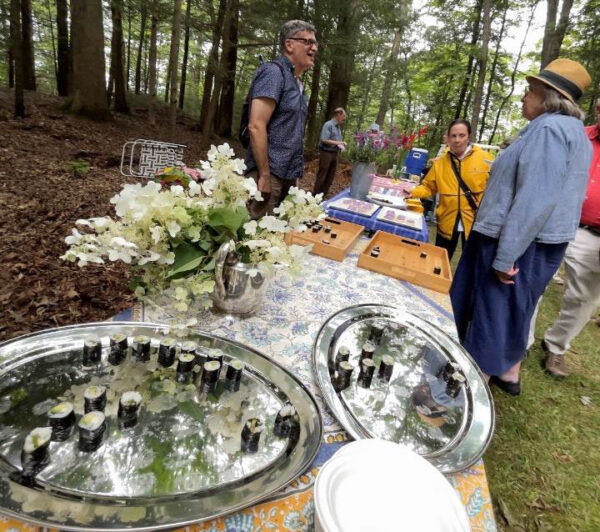
Selectman and former LHA Treasurer, Patrick White (center) chats with Julie Edmonds (in blue) at the sushi table

Vice-President Mark Siegars (blue cap) at one of two tables with Red Lion Inn sweets.
All the Association board members were in attendance (a first in this Secretary’s memory.) All had participated in the event in some way, either planning, working, or presenting.
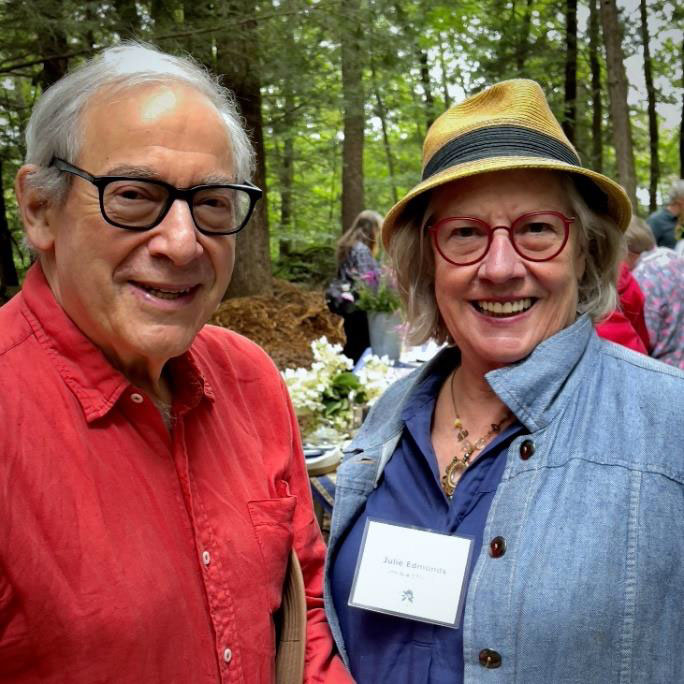
Board member and Refreshments Chair, Julie Love Edmonds with her husband, Barney
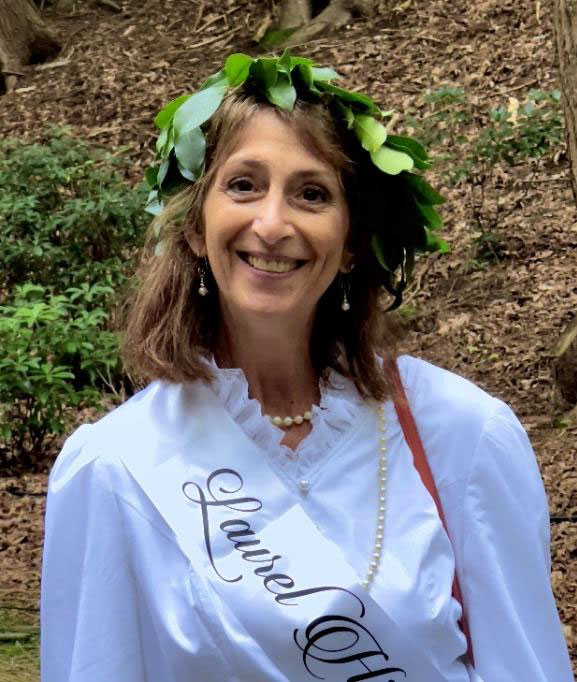
Board Member and Suffragette Lis Wheeler
Afterwards, things were packed up and the Rostrum glen was once again quiet. The gentle sprinkles had not marred another successful Laurel Hill Day.
Respectfully submitted,
Patricia Flinn, Secretary
Thanks go to Lionel Delevingne, Pat Flinn and Jim Schantz for the pictures.
Thanks also to John Drake and his golf cart for helping to ferry folk and supplies up and down the hill. (The Stockbridge Golf Course was not able to supply carts as mentioned in the Program.)
